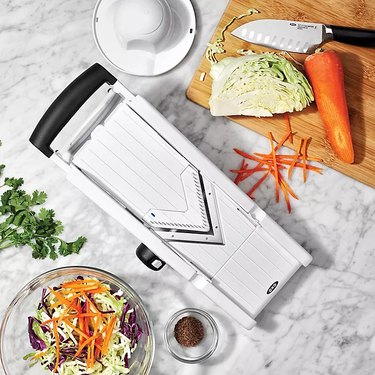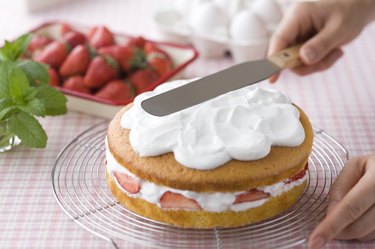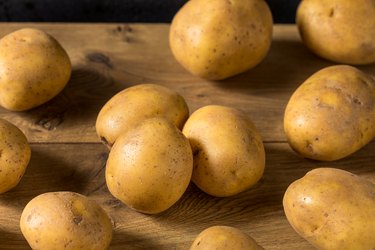
There are few things as versatile (and delicious) as potatoes. But even though spuds are basically a super staple, potatoes can be particularly prone to mishaps during the cooking process. Just ask anyone who's ever made unevenly cooked scalloped potatoes or not-so-crisp french fries!

Video of the Day
With that in mind, we decided to put together an ultimate guide to getting potatoes right. First we'll review the best potato varieties for different dishes to ensure your cooking gets off to the right start. Then we'll go over some of the common ways potato recipes can go awry and what you can do to salvage them before you or your family digs in.
Video of the Day
So let's get started! First thing's first, let's review potato types...
How to Pick the Right Potato Variety
"Meat and potatoes" is used as a figure of speech for simple cookery. Yet potatoes, in all their glorious varieties, are anything but simple. Growing conditions, storage methods and even storage time can affect how they cook. After all, potatoes are grown in fields, not built in factories. This means there are many ways to mess up your spuds, no matter how you cook them.
One of the most important things you can do is simply choose the right potato for the job. Broadly speaking, you'll see three kinds of spuds in stores:
1. Starchy Potatoes: Like the classic russet potatoes, which are ideal for baking, french fries, scalloped potatoes and mashing.
2. Waxy Potatoes: Fingerlings and most red or yellow varieties, which are ideal for boiling or potato salads.
3. All-Purpose Potatoes: Varieties such as Yukon Gold, which as the name suggests, will work in most dishes.
You're a lot less likely to have problems if you start with a potato that's appropriate for your recipe. An easy rule of thumb? If your cooking method involves water or broth, use a waxy or all-purpose potato. If it doesn't, use a russet. It's as easy as that!
Question: Why Won't My Potato Soften?
Occasionally, you might get a potato that just won't soften, no matter how long you cook it. It's nothing you've done; potatoes can sometimes get that way if there's a cold snap during the growing season. A pressure cooker can eventually tame them, but your best bet is usually to discard that particular spud and try again with a different one.
1. Baked Potato Problems

The baked potato process sounds simple: You pop well-scrubbed spuds into the oven and take them out once they're cooked through. That being said, there's a big difference between a perfect baked potato—crisp-skinned on the outside, light and fluffy on the inside—and the end result a lot of us wind up with, aka a leathery and soggy mess!
Problem 1: "The potato’s skin is leathery."
THE DISH: If you've oiled your potato before cooking (as many recipes advise), that might be the culprit. Oiling 10 to 20 minutes from the end of cooking time is plenty to make the skin extra-crisp. You might also have simply baked the potato too long at a high temperature or let it sit too long before serving. (Steam from inside the potato will turn a crisp skin leathery.)
THE SOLUTION: If you've baked the potato too long, simply pop the potato back in the oven for a few minutes to crisp up the skin again. Otherwise, your best way to save the situation might be to scoop out the innards, mash them with herbs, cream or cheese and then make twice-baked potatoes.
Problem 2: "My potato exploded!"
THE DISH: This is why most cookbooks advise poking potatoes with a fork or skewer before baking. Doing so provides a path for steam to escape from the potato as it cooks—otherwise, there's a risk that the steam will make its own exit and your potato will burst open. Letting the steam out helps keep baked potatoes light, dry and fluffy when they're done.
THE SOLUTION: If your potato isn't fully cooked when it goes kablooey, finishing it in the oven will dry it out. Instead, try microwaving it until done—the potato won't have a crisp skin, but it'll be perfectly edible. If the potato is cooked when the explosion happens, remove it from the oven right away and keep it warm until you're ready to serve. If you've lost a lot of potato to the inside of the oven, you can microwave a smaller potato until it's cooked, then mash it up and add it to the afflicted spud. If all else fails, fall back on twice-baked potatoes to salvage the situation.
Problem 3: "The potato is soggy inside."
THE DISH: Sogginess is another potential outcome if you haven't perforated your potato well enough. It can also happen with new-crop russets (which contain more moisture than long-stored potatoes) or if you've baked waxy potatoes instead of starchy potatoes.
THE SOLUTION: There are a few potential fixes. One is to slit the potatoes' tops and squeeze them open, as you would to serve them, and pop them back into the oven on low heat for a few minutes to cook out some excess moisture. You could opt for twice-baked potatoes here, as well. A third alternative is to shift gears: Slice the potatoes into rounds or chunks and brown them for a few minutes in a hot skillet with a bit of oil (and ideally some thinly-sliced onion). It's not ideal if you had your heart set on baked potatoes, but it's a good "save."
2. Scalloped Potato Problems
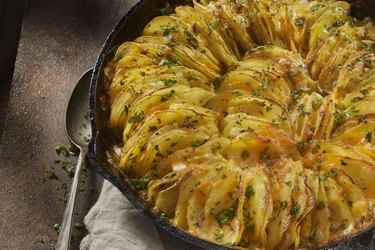
Scalloped potatoes and their various equivalents (gratins and such) consist of potatoes cooked in the oven with rich and creamy sauce. When they work, they're a wonderful side dish. When they don't, they're maddening.
Problem 1: "The scalloped potatoes aren’t fully cooked."
THE DISH: Ideally, scalloped potatoes are fully cooked just when the sauce has nicely thickened. If your sauce has thickened but your potatoes aren't finished cooking, there are a few possible explanations. Your potatoes might have been sliced too thickly, you might not have made enough sauce or your oven might be too hot (boiling away excess moisture before potatoes fully cook).
THE SOLUTION: Most of the issues above are things you can fix next time. For now, your best fix is to add more liquid and put the scalloped potatoes back in the oven. Heat up some milk in the microwave (don't add cold milk, as your casserole dish will often break if you do) and pour it over the potatoes. By the time the extra liquid has cooked down, your potatoes should be done. If not, repeat the same process. If time is short and your casserole dish fits into the microwave, you can opt to finish the potatoes that way.
Problem 2: "The scalloped potatoes are only cooked in some areas."
THE DISH: If your potatoes aren't cooking evenly, it's usually because you haven't cut them with a consistent thickness. This consistency is vital for scalloped potatoes, so if you own a mandoline slicer (or a food processor with a slicing attachment), now is the perfect time to use it. Another potential explanation—if one side of the dish is cooked and the other isn't—is that your oven might be heating unevenly or other dishes in the oven are blocking airflow to your potatoes.
THE SOLUTION: If uneven heating is the issue, rotating your casserole dish and letting it cook a little longer will probably fix the problem. If it's because your potatoes weren't sliced evenly, follow the same routine (add hot milk, return to oven) used to remedy undercooked potatoes.
Problem 3: "The sauce isn’t thickening."
THE DISH: A creamy, thick sauce is part of what makes scalloped potatoes delicious—so if it's not coming together, that's a real problem. There are a few reasons your sauce might be runny. One is that it simply needs to cook longer. Another is that you might not have chosen the kind of potato the recipe calls for—remember our crash course above? Waxy and starchy potatoes alike can make a perfectly tasty completed dish, but starchy potatoes help thicken the sauce while waxy potatoes don't.
THE SOLUTION: If your potatoes are holding together nicely, you can simply leave your dish in the oven until the sauce properly thickens. If you're in a hurry or worried about your potatoes turning to mush, carefully pour your sauce from the potatoes into a small saucepan, thicken on the stovetop with cornstarch or a similar thickener, add it back to the cooked potatoes and return to the oven. After just a few minutes at high temperature to brown the surface, your dish will be ready to serve.
3. French Fry Problems
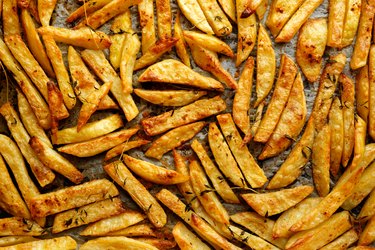
There's a reason french fries are a classic eating-out food: They're kind of a pain to make at home. You need to slice them into perfectly uniform sticks, so they'll cook evenly, and the cooking process itself has multiple steps. And that's not to mention the inconvenience (and risks) involved in deep frying. If you do decide to give it a try, there are a couple of common ways things can go amiss.
Problem 1: "The fries are getting too dark."
THE ISSUE: If your fries are browning before they're properly cooked, there are a couple of possible explanations. One possibility—especially with newly purchased potatoes—is that they've recently been removed from cold storage. When potatoes are chilled, some of their starches convert to sugar (a natural anti-freeze), which means they'll caramelize and brown quickly. Excess surface starch can also cause browning, or you may simply be cooking them at too high a temperature. Most important, the best fries are par-cooked first at low temperature (blanching) and, after they cool, browned and finished at a higher temperature.
THE SOLUTION: If you haven't blanched your fries, they're salvageable with quick action. Remove any uncooked fries and rinse them thoroughly in cold water to remove as much surface starch as possible. Shake and drain them as much as possible or turn them out onto clean towels and blot dry. Next, turn the heat in your fryer down to no more than 325°F (lower if your fries are larger than 1/4-in.) and cook them in small batches until golden brown. They won't stay crisp as long as twice-cooked fries, but they'll be tasty. The overly browned fries you've already cooked can be microwaved to finish cooking, but they won't be crisp. Your best bet is to set those aside, dice them up later and pan-fry them for breakfast or brunch.
Problem 2: "The fries just aren’t crisp."
THE DISH: If your fries aren't crisping up in the fryer, it might be because you've chosen the wrong potato. Some people prefer Yukon Golds for fries, but your best bet is old-crop russets—a waxy potato won't make good, crisp fries. Usually, though, a lack of crispiness just means you're trying to cook too many fries at once. When you drop your potatoes into the hot fat, they bring down its temperature. The more potatoes you add, the lower the temperature will get, resulting in soggy fries.
THE SOLUTION: If you're using a countertop deep fryer, wait for it to come back up to temperature (there's usually an indicator light) and add a much smaller handful of fries to the oil (just 8 to 10 at a time will do). They should cook to golden brown within minutes and you can turn them out to drain on a paper-lined plate. For the floppy fries you've already got, a few minutes in the oven or toaster oven should brown and crisp them properly while you continue frying the remaining spuds.
4. Hash Brown Problems
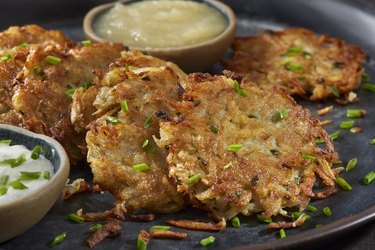
Fried potatoes are easy to love. Frying usually means you're using leftover cooked potatoes, which tend to be pretty bulletproof. The exceptions are french fries (which we've just covered) and shredded potatoes, whether you call them hash browns or potato pancakes.
Problem 1: "The potatoes are falling apart."
THE DISH: The point of the exercise here is to let your hash browns or potato pancakes develop a crisp, golden surface on the outside while the potatoes steam themselves to a soft and fluffy interior texture. If they crumble and fall apart, it's almost invariably because you need to be more patient.
THE SOLUTION: Let the potatoes sit a bit longer! Don't poke them, move them or get under them with the spatula until they're completely set and golden on the underside. If they're browning faster than the potatoes can cook, turn the heat down or add more oil. As they cook and become golden, the potato shreds will fuse together and you'll be able to flip your potato pancake (or mound of hash browns) without crumbling. Repeat process with the second side.
Problem 2: "My hash browns are gummy in the middle."
THE DISH: Sometimes, instead of light and fluffy, potatoes come out dense and gummy in the middle. You won't see this if you make your hash browns with precooked potatoes, but it's a possibility when you're using freshly shredded raw potatoes. The problem is the starch that's released during shredding, which results in a stodgy texture upon cooking (like overcooked rice).
THE SOLUTION: Set aside the potatoes you've already cooked and turn off the burner for a moment. Take the potatoes you haven't cooked and dump them into a large mixing bowl. Rinse them repeatedly with cold water until the water runs clear. Next, drain thoroughly (wringing the potatoes out in a clean kitchen towel works well) and try again. This time, you'll likely find that they cook up properly. As for the ones you'd already cooked, your best bet is to pop them in a hot oven or toaster oven and crisp to retain as much crispiness as possible. The texture still won't be quite right, but they won't go to waste.
5. Mashed Potato Problems

For such a simple dish, it's surprising how many (often elaborate) mashed potato recipes you'll find online. Recipes will refer to pushing potatoes through a food mill or potato ricer to make them extra light and fluffy, expound earnestly on the importance of using heated milk and melted butter, or get into serious scientific debate over whether cream or milk is the better option. Realistically, you can get perfectly good, fluffy mashed potatoes with just a potato masher and no special preparation—though there are a few potential potato pitfalls to consider.
Problem 1: "My mashed potatoes are too watery."
THE DISH: Watery mashed potatoes is one of the most common dilemmas, and it's usually because you tried to make them in a hurry. Russets make the best mashed potatoes, but they're also prone to overcooking in boiling water. If you cut them too small in hopes they'll cook faster, you'll end up with watery potatoes. For future reference, the pieces should be no smaller than 1 and 1/2 to 2 in., and you can quickly remove excess moisture by returning the pot to the burner to steam off lingering water. Unfortunately, that doesn't help you right now.
THE SOLUTION: What will help are instant mashed potatoes, if you have any around. Add them to your existing potatoes a tablespoon or two at a time and stir until the consistency improves. Set the combined potatoes aside for a few minutes so the instant potatoes can finish absorbing moisture from your "real' potatoes. If you don't have any instant on hand, microwave a medium-sized potato until it's soft, mash it and add it to the rest of the potatoes to help firm up the rest of the batch. Note that this same technique also works if you've added too much milk to your potatoes.
Problem 2: "The mashed potatoes are lumpy."
THE DISH: Lumpy mashed potatoes usually happen because potato pieces haven't been cooked all the way through—either because you were in a hurry or because the size of the potatoes was inconsistent (some were fully cooked, some weren't). It can also happen if potatoes are cooked at too high a boil (simmering is better than a hard boil), which creates an overcooked exterior and undercooked interior.
THE SOLUTION: Your best bet is to use a flexible spatula or "spoonula" to push the potatoes through a wire-mesh sieve or to run them through a food mill. The un/undercooked bits of potato will stay behind, and you can save them for tomorrow's hash browns. The rest of the potatoes can be finished up with the usual butter, salt, pepper and milk or cream, though you might find they need a bit of reheating.
Problem 3: "My mashed potatoes are gummy."
THE DISH: Gumminess is the one potato problem you really don't want to run up against. Gummy mashed potatoes happen because you've overworked spuds enough to release starches trapped in their cells. It's frustratingly easy to do with mixer or food processor, but you can also do it by hand with a regular ol' masher if you're a bit overzealous.
THE SOLUTION: There's no way to undo gummy mashed potatoes, so the best you can hope for is to improve the texture enough to make them passable. Your best bet is to stir in melted butter, which lubricates the starch molecules and helps keep them from sticking together. Another option is to stir in instant mashed potatoes or a freshly cooked and mashed potato to add some of that "normal potato" texture. Combining both butter and extra potatoes works best of all.
